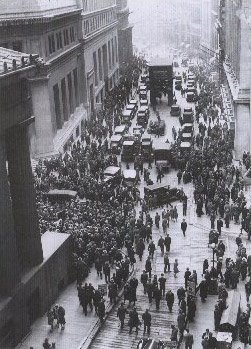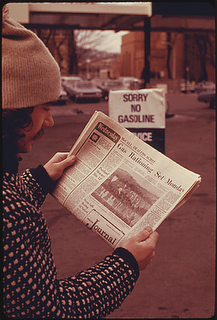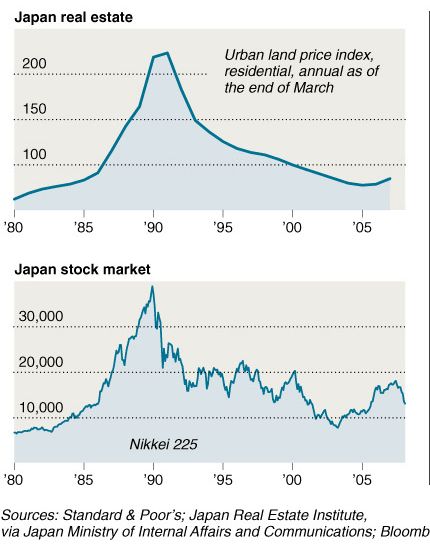Credit deflation and the Japanese problem
The world has experienced three periods of extreme financial dislocation in the past century, 1929, 1973, and 1990. Two of these have been deflationary. While most observers have their eyes firmly peeled on 1973 and its aftermath, 1929 and 1990 are the scenarios of greatest concern today. These deflationary periods should be instructive as to what the worst case scenario is in this financial crisis as debt deflation is the longer term risk. I will examine 1929 from a U.S. perspective. 1973 from a UK perspective and 1990 from a Japanese perspective as these were the economies hardest hit in each of these episodes.
1929
 1929 is the most feared year in global economic year. Merely mentioning that year evokes thoughts of economic cataclysm, which brought chaos, the seeds of fascism, and the staging ground for world war. The Great Depression is a period that all economic historians want to ensure we do not repeat.
1929 is the most feared year in global economic year. Merely mentioning that year evokes thoughts of economic cataclysm, which brought chaos, the seeds of fascism, and the staging ground for world war. The Great Depression is a period that all economic historians want to ensure we do not repeat.
Pre-Depression financial speculation led to an apocalyptic collapse that ushered in a period of severe economic contraction globally. Most economists, including the likes of Fed Chairman Ben Bernanke, accept the Milton Friedman version of events — that the Depression was a result of insufficient monetary liquidity. The belief is that the Federal Reserve and other central banks stuck to the ‘hard money’ dogma of the gold standard and failed to supply adequate liquidity to banks. This is why the U.S. suffered a massive wave of bank failures while there were virtually none in countries like Canada and the UK.
1973
 However, most economists seem to have fixated on 1973 as the year to avoid today. This is largely because most of us were alive and can remember the awful inflationary spiral that began that year. The UK was one of the most severely affected economies. The markets plunged. In the UK, the FTSE all shares index reached a high of 228.18 in 1972, only to plunge to 61.92 by 1974, a stunning loss of 73%. With the Retail Price Index (RPI) running at 7.5% in 1972, 9.1% in 1973 and 15.9% in 1974, the losses in the 1973-74 for UK investors Bear market were over 90% in inflation-adjusted terms. In 1974, the RPI reached 24.1% before inflation started to come down. Needless to say, this was a real trauma.
However, most economists seem to have fixated on 1973 as the year to avoid today. This is largely because most of us were alive and can remember the awful inflationary spiral that began that year. The UK was one of the most severely affected economies. The markets plunged. In the UK, the FTSE all shares index reached a high of 228.18 in 1972, only to plunge to 61.92 by 1974, a stunning loss of 73%. With the Retail Price Index (RPI) running at 7.5% in 1972, 9.1% in 1973 and 15.9% in 1974, the losses in the 1973-74 for UK investors Bear market were over 90% in inflation-adjusted terms. In 1974, the RPI reached 24.1% before inflation started to come down. Needless to say, this was a real trauma.
The problem in 1973 was commodity prices and inflation. The common belief is that monetary authorities, still remembering 1929 and its debt deflation, failed to stem the tide of rising inflation which ravaged the world’s economies for nearly a decade in a wage-price spiral.
1990
 Then, there is 1990s Japan. Japan had a decade or more of ridiculous stock market and property market increases that led to the Bubble Economy. Famously, the Nikkei peaked on 29 Dec 1989, at 38, 916 after a five year return of 237%. Today the Nikkei sits at 14, 354, a full 63% lower than it was nearly two decades ago.
Then, there is 1990s Japan. Japan had a decade or more of ridiculous stock market and property market increases that led to the Bubble Economy. Famously, the Nikkei peaked on 29 Dec 1989, at 38, 916 after a five year return of 237%. Today the Nikkei sits at 14, 354, a full 63% lower than it was nearly two decades ago.
Ben Bernanke, student of the Great Depression, believes that Japan suffered a loss decade because monetary authorities failed to react quickly enough to deflationary threats in the economy. He is nicknamed ‘Helicopter Ben’ for the following pronouncement he gave in talking about the U.S. avoiding a Japanese scenario in 2002:
The U.S. government has a technology, called a printing press — or, today, its electronic equivalent — that allows it to produce as many U.S. dollars as it wishes at essentially no cost.
–Ben Bernanke November 22, 2002
Today’s Fear: 1973
So, the obvious question is: which horrible period of declining asset values and financial turmoil is most frightening today and what can we do to make sure we avoid it? From recent pronouncements by officals at the three most prestigious central banks, the ECB (European Central Bank), the U.S. Federal Reserve, and the BoE (Bank of England), we can safely assume 1973 is the model they are most concerned about. Everybody fears inflation right now. But, what if that’s not the problem?
See, 1973 didn’t have the extremes of credit and debt that we see today and saw in 1929 and in 1990 Japan. 1973 was a case of too much monetary liquidity (true inflation) spilling over into price inflation. On the other hand 1929 and 1990, were cases of too much monetary liquidity creating a debt bubble and spilling over into asset inflation. The central difference is the debt.
The Real Problem: Debt Deflation
Debt is a special problem because we live in a fractional reserve banking system. Murray Rothbard, one of the most esteemed economists of the Austrian School, said:
“The Ricardian analysis of the business cycle went something as follows: The natural moneys emerging as such on the world free market are useful commodities, generally gold and silver. If money were confined to these commodities, then the economy would work in the aggregate as it does in particular markets: A smooth adjustment of supply and demand, and therefore no cycles of boom and bust. But the injection of bank credit adds another crucial and disruptive element. For banks expand credit and therefore bank money in the form of notes or deposits which are theoretically redeemable on demand in gold, but in practice clearly are not.”
–“Economic Depressions: Their Cause and Cure,” Murray Rothbard
Basically, Rothbard is saying that inflating available credit through banks’ lending money they don’t have creates a natural boom-bust cycle. Banks go overboard at some point in time, banks suffer credit losses, banks then become more conservative, and credit contracts accordingly.
So when debt is high relative to GDP and disposable income, when debt servicing costs are high relative to income, the contraction of credit is a problem. When credit contracts and banks lend neither to one another or to customers out of fear and in order to protect their own assets, people go bankrupt. This infects the real economy and in turn creates more bad debt, which causes banks to contract credit further in a negative feedback loop. So-called money velocity goes down.
This is what happened to Japan in 1990 and what happened to the U.S. in 1929. Economic stimulus in the form of easy money has no effect on this process because low interest rates and monetary liquidity cannot force people to lend or borrow when credit is contracting. This is also what is happening right now in the UK and in the US. These two countries have much too much debt and cannot take on further credit. Easy money is no panacea because it cannot counteract the inherent deleveraging of an overleveraged financial sector.
What to do?
 The BoE and the Fed should allow the credit unwind process to proceed on course. If and when systemic risk appears, the central banks can step in with liquidity at penalty rates. This was the original plan that Mervyn King wanted to adopt. However, he lost his nerve when Northern Rock went to the wall. Had King allowed Northern Rock to fail and liquidated its balance sheet over a longer time frame, we might have been able to pull out of this crisis sooner. But, King and Bernanke have lost their way and are bowing to political pressure.
The BoE and the Fed should allow the credit unwind process to proceed on course. If and when systemic risk appears, the central banks can step in with liquidity at penalty rates. This was the original plan that Mervyn King wanted to adopt. However, he lost his nerve when Northern Rock went to the wall. Had King allowed Northern Rock to fail and liquidated its balance sheet over a longer time frame, we might have been able to pull out of this crisis sooner. But, King and Bernanke have lost their way and are bowing to political pressure.
The Japanese problem is instructive as it actually demonstrates more that easy money is not the way forward. The Nordic Bubble workout of the early 1990s may be the best paradigm for a worried Fed and BoE.
Ultimately, it is the political solutions that will make this crisis longer and deeper.
Update: See post on Japanese stock market crash charts at Chart of the day: Japan 1984-2004
Other posts on Japan can be found under the label ‘Japan‘.
Sources and Additional Reading
The Austrian Theory of the Trade Cycle, Ludwig von Mises, Gottfried Haberler, Murray Rothbard, Friedrich Hayek
A History of the Modern British Isles 1914-1999, Arthur Marwick
Panic on Wall Street, Robert Sobel
A Monetary History of the United States, 1867-1960, Milton Friedman and Anna Jacobson Schwartz
The World in Depression 1929-1939, Charles Kindleberger
Manias, Panics, and Crashes, Charles Kindleberger,
Devil Take The Hindmost, Edward Chancellor
Japan as Number One, Ezra Vogel
The Bubble Economy, Christopher Wood
Ed, excellent summary. But I’m not sure you have answered the questions:
1. Which bubble is most similar to the one we have now (I guess Japan 1990).
2. What is the least-worst way out of it (I think you answered this), and
3. What should we do (if anything) about preventing asset-price bubbles (the flipside of the 1929 and 1990 credit bubbles) in future?
Mark,
I do think 1990 Japan is the most similar comparison. 1929 can’t be ruled out if the central banks screw it up or we go protectionist. But I don’t see 1973 as the same because inflation was more ingrained, unions had all sorts of cost of living adjustments tied in to contracts so you had a wage price spiral. I am a lot less worried about inflation than most people.
As far as the least-worst way, I think mildly elevated inflation, which is what we’ve got will be the way forward. The only danger here is that commodity prices continue up so much tha inflation becomes ingrained in a wage price spiral. But, its harder to get high inflation numbers going forward because we have already gone so high. For example, if oil goes from $80 to $120 then to match that rise it has to go to $180 still. I could be wrong but I think commodity price inflation will go down or even reverse course before the recession is done.
Oh and your third question is the best of all. I’m sure you and I would agree that its not easy money. I’ll take that one up in a separate entry! As you said in the post on Alice’s site, its time to reward savers over debtors. I’m all for that as the way to prevent this sort of thing.
Ed